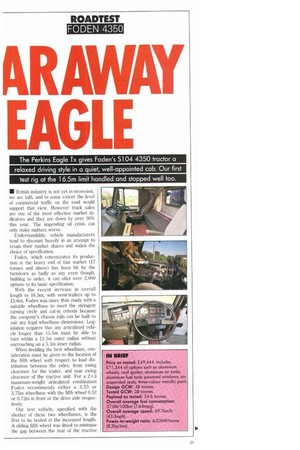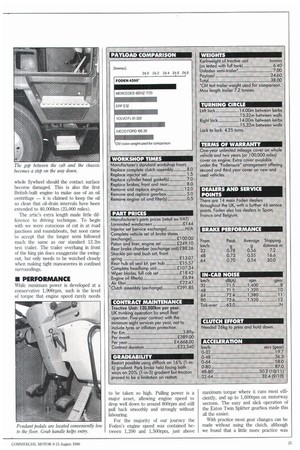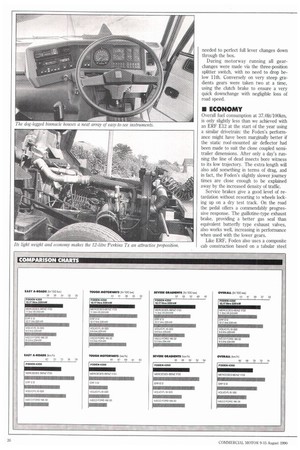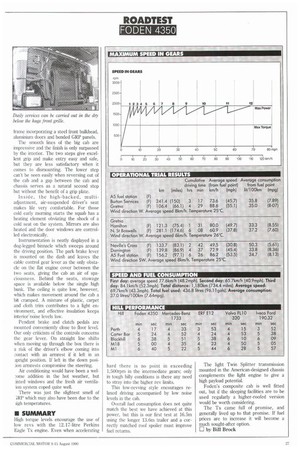RAWAY EAGLE
Page 25

Page 26

Page 27

Page 28

Page 29

If you've noticed an error in this article please click here to report it so we can fix it.
The Perkins Eagle Tx gives Foden's S104 4350 tractor a relaxed driving style in a quiet, well-appointed cab. Our first test rig at the 16.5m limit handled and stopped well too.
• British industry is not yet in recession, we are told, and to some extent the level of commercial traffic on the road would support that view. However truck sales are one of the most effective market indicators and they are down by over 30% this year. The impending oil crisis can only make matters worse.
Understandably, vehicle manufacturers tend to discount heavily in an attempt to retain their market shares and widen the choice of specification.
Foden, which concentrates its production at the heavy end of that market (17 tonnes and above) has been hit by the turndown as badly as any even though, building to order, it can offer over 2,000 options to its basic specification.
With the recent increase in overall length to 16.5m, with semi-trailers up to 13.6m, Foden was more than ready with a suitable wheelbase to meet the stringent turning circle and cut-in criteria because the company's chassis rails can be built to suit any legal wheelbase dimensions. Legislation requires that any articulated vehicle longer than 15.5m must be able to turn within a 12.5m outer radius without encroaching on a 5.3m inner radius.
When deciding the best wheelbase, consideration must be given to the location of the fifth wheel with respect to load distribution between the axles, front swing clearance for the trailer, and rear swing clearance of the tractive unit. For a 2+3 maximum-weight articulated combination Foden recommends either a 3.55 or 3.75m wheelbase with the fifth wheel 0.52 or 0.72m in front of the drive axle respectively.
Our test vehicle, specified with the shorter of these two wheelbases, is the first to be tested at the increased length. A sliding fifth wheel was fitted to minimise the gap between the rear of the tractive
unit and the front of the trailer and to improve aerodynamics. The Crane Fruehauf semi-trailer, fitted with a Boalloy Tautliner curtainsided body, was 1.4m longer than our regular trailer and weighed in at 7.2 tonnes, incurring a weight penalty of 0.2 tonnes.
The Foden tractive unit is powered by Perkins' latest 12.17-litre Eagle 325 Tx charge-cooled unit. It weighs just 6.4 tonnes fully fueled and ready for the road, helped by alloy wheels, but without the fifth-wheel lead-up ramps which are normally fitted with steel suspended chassis. Foden's drive-axle air suspension, which adds about 2% to the unladen weight, allows easy matching of chassis and trailer heights when coupling.
As can be seen from the payload comparison chart this tractive unit offers the best payload in its class at about 245kW (325hp). Fitting the smaller capacity LTAA10-325 Ctunmins engine could save around 240kg, but the Perkins Tx with its very high level of torque (peaking at 1,559Nm at just 1,000rpm) promises a greater potential for economy and reliability.
The engine incorporates a number of innovative features such as leak-proof joints which are designed to swell on contact with oil, and a replaceable flywheel friction plate which avoids changing the whole flywheel should the contact surface become damaged. This is also the first British-built engine to make use of an oil centrifuge it is claimed to keep the oil so clean that oil-drain intervals have been extended to 40,000km (25,000 miles).
The artic's extra length made little difference to driving technique. To begin with we were conscious of cut in at road junctions and roundabouts, but soon came to accept that the longer semi followed much the same as our standard 12.2m test trailer. The trailer overhang in front of the king pin does exaggerate the swingout, but only needs to be watched closely when making tight manoeuvres in confined surroundings.
• PERFORMANCE
While maximum power is developed at a conservative 1,900rpm, such is the level of torque that engine speed rarely needs
to be taken so high. Pulling power is a major asset, allowing engine speed to drop well down to around 800rpm and still pull back smoothly and strongly without labouring.
For the majority of our journey the Foden's engine speed was contained between 1,200 and 1,500rpm, just above maximum torque where it runs most efficiently, and up to 1,600rpm on motorway sectons. The easy and slick operation of the Eaton Twin Splitter gearbox made this all the easier.
With practice most gear changes can be made without using the clutch, although we found that a little more practice was needed to perfect full lever changes down through the box.
During motorway running all gearchanges were made via the three-position splitter switch, with no need to drop below 11th. Conversely on very steep gradients gears were taken two at a time, using the clutch brake to ensure a very quick downchange with negligible loss of road speed.
• ECONOMY
Overall fuel consumption at 37.01it/100km, is only slightly less than we achieved with an ERF E12 at the start of the year using a similar drivetrain: the Foden's performance might have been marginally better if the static roof-mounted air deflector had been made to suit the close coupled semitrailer dimensions. After only a day's running the line of dead insects bore witness to its low trajectory. The extra length will also add something in terms of drag, and in fact, the Foden's slightly slower journey times are close enough to be explained away by the increased density of traffic.
Service brakes give a good level of retardation without resorting to wheels locking up on a dry test track. On the road the pedal offers a commendably progressive response. The guillotine-type exhaust brake, providing a better gas seal than equivalent butterfly type exhaust valves, also works well, increasing in performance when used with the lower gears.
Like ERF, Foden also uses a composite
cab construction based on a tubular steel
frame incorporating a steel front bulkhead, aluminium doors and bonded GRP panels.
The smooth lines of the big cab are impressive and the finish is only surpassed by the interior. The two steps give excellent grip and make entry easy and safe, but they are less satisfactory when it comes to dismounting. The lower step can't be seen easily when reversing out of the cab and a gap between the cab and chassis serves as a natural second step but without the benefit of a grip plate.
Inside, the high-backed, multiadjustment, air-suspended driver's seat makes life very comfortable. For those cold early morning starts the squab has a heating element obviating the shock of a cold seat on the system. Mirrors are also heated and the door windows are controlled electronically.
Instrumentation is neatly displayed in a dog-legged binnacle which sweeps around the driving position. The park brake lever is mounted on the dash and leaves the cable control gear lever as the only obstacle on the flat engine cover between the two seats, giving the cab an air of spaciousness. Behind the seats, stowage space is available below the single high bunk. The ceiling is quite low, however, which makes movement around the cab a bit cramped. A mixture of plastic, carpet and cloth trim contributes to a light environment, and effective insulation keeps interior-noise levels low.
Pendant brake and clutch pedals are mounted conveniently close to floor level. Our only criticism of the controls concerns the gear lever. On straight line shifts when moving up through the box there is a risk of the driver's elbow coming into contact with an armrest if it left in an apright position. If left in the down posi:ion armrests compromise the steering.
Air conditioning would have been a wel:ome addition in the hot weather, but .inted windows and the fresh air ventilaion system coped quite well.
There was just the slightest smell of ;RP which may also have been due to the iigh temperatures.
• SUMMARY
High torque levels encourage the use of low revs with the 12.17-litre Perkins Eagle Tx engine. Even when accelerating
hard there is no point in exceeding 1,500rpm in the intermediate gears; only in tough hilly conditions is there any need to stray into the higher rev limits.
This low-revving style encourages relaxed driving accompanied by low noise levels in the cab.
Overall fuel consumption does not quite match the best we have achieved at this power, but this is our first test at 16.5m using the longer 13.6m trailer and a correctly matched roof spoiler must improve fuel returns. The light Twin Splitter transmission mounted in the American-designed chassis complements the light engine to give a high payload potential.
Foden's composite cab is well fitted out, but if the sleeping facilities are to be used regularly a higher-roofed version would be worth considering.
The Tx came full of promise, and generally Lived up to that promise. If fuel prices are to increase it will become a much sought-after option.
by Bill Brock
















































































